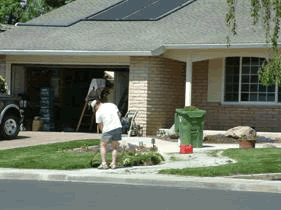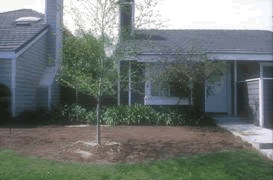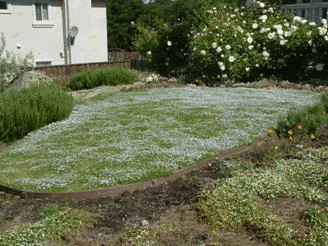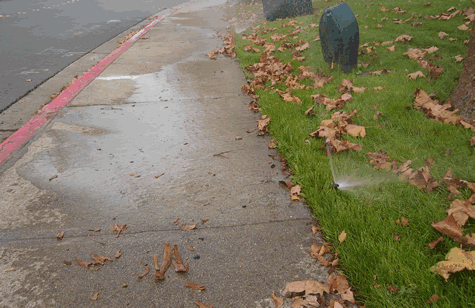|
Lawn
Lawn is the highest water-consuming feature of your landscape. It also requires frequent maintenance. If you plan to include a lawn in your landscape, consider installing 800 square feet or less. This will help make landscape watering and maintenance more manageable.

Hard at work on the front lawn.
Consider reducing an existing lawn. A small, well-designed lawn can be just as enjoyable as an overly large expanse of grass, and takes less time to fertilize, irrigate, and mow.

This homeowner has decreased the lawn size
which has lessened the need for water and
long-term maintenance.
While a lawn provides a soft surface for children’s play and sports activities not every garden needs a lawn. Consider substituting with a groundcover, go to Plant Lists under Plants on the Main Menu, or patio.

The Blue Star Creeper ground cover makes an attractive
Alternative to lawn.
Tips for a healthy lawn:
| • | Evaluate your sprinkler system. Inspect, fine tune, and if necessary, upgrade your existing sprinkler system to save water. |
| • | Install mowing strips, also called mow bands, around the perimeter of your lawn. A ribbon of smooth concrete, brick, or decorative flat pavers, just wide enough to accommodate the wheels of your lawnmower, will allow you to cut to the very edge of the grass, eliminating hand-trimming and preventing damage to flowers or ground covers that border your lawn. |
| • | Do not over-fertilize your lawn. Fertilizer contains nitrogen, and too much nitrogen encourages fast growth. In place of store-bought fertilizers, try to fertilize your lawn naturally. Compost, and manure return needed bacteria, enzymes, and nutrients to the soil. Another option is to make your lawn self-fertilizing by including clover or other nitrogen-enhancing plants in the lawn. |
| • | Hand-pull weeds as they appear. Weeds rob your lawn of water and nutrients while crowding out desirable grasses. Apply a pre-emergent herbicide (prevents weeds) as a last resort for major weed infestations. |
| • | De-thatch lawn in late spring or early summer to keep it healthy. |
| • | Add compost to loosen the soil and allow water to penetrate to the roots. |
| • | Raise the height of your mower to encourage deeper roots and hold moisture in the soil. Close and frequent mowing stresses grass. Lawn height guideline: |
| ▪ | 2 to 2 ½ inches for bluegrass and fescue |
| ▪ | 2 to 3 inches for tall fescue |
| • | Be sure to cut turf grass away from sprinkler heads. |
| • | A sharp mower blade will provide a clean cut and causes less stress on grass. |
| • | Have your lawn aerated. Aeration will improve water penetration and encourage deeper roots. The plugs produced by aeration should be left on the lawn, as they can help decompose thatch. |
| • | If bare spots or thinning lawn is a problem, adjust the sprinklers to apply water evenly. Water from each sprinkler head should just reach adjacent sprinkler head (“head-to-head” coverage) to maximize even watering. If this fails to correct the problem, try reseeding bare and thinning spots. |
| • | Adjust sprinklers to water planting areas only. Avoid watering sidewalks, driveways, patios, and structures. |
| • | Watering your lawn in three short cycles is better that one long cycle. By dividing the watering time into thirds and having one hour between start times, will reduce water runoff. |

Water time is too long, resulting in runoff. Break run times into short cycles to allow the water to soak into the soil.
| • | Water infrequently, but thoroughly. Watering to a depth of four to six inches will encourage deeper, healthier root development and allow the turf to go without water for longer periods of time. (See Watering Tips on the Main Menu) |
| • | It is not advisable to plant a tree in your lawn, particularly native oaks. Many trees are susceptible to Armillaria mellea (root rot) if they receive as much water as is needed for a healthy lawn. As the tree matures, the lawn will get less and less sunlight resulting in gradual decline until there is no lawn, yet the tree will continue to receive the water and very possibly develop the disease. Also, watering a lawn placed under a tree causes the roots of the tree to grow toward the surface rather than down, causing instability and a very lumpy yard. Instead of lawn, use an attractive layer of stone mulch under trees. |
| • | Click here for more information on maintaining a healthy and beautiful lawn. |
|
